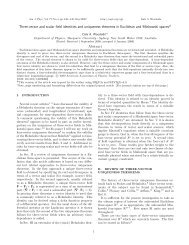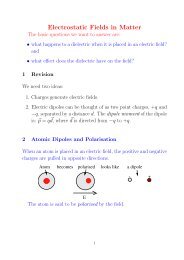Chapter 8 Vector Spaces in Quantum Mechanics
Chapter 8 Vector Spaces in Quantum Mechanics
Chapter 8 Vector Spaces in Quantum Mechanics
You also want an ePaper? Increase the reach of your titles
YUMPU automatically turns print PDFs into web optimized ePapers that Google loves.
<strong>Chapter</strong> 8 <strong>Vector</strong> <strong>Spaces</strong> <strong>in</strong> <strong>Quantum</strong> <strong>Mechanics</strong> 96can be set up. An important example is one <strong>in</strong> which the system consists of a possiblyvariable number of identical particles. One example is a ‘gas’ of photons, all of the samefrequency and polarization. Such a situation is rout<strong>in</strong>ely achieved <strong>in</strong> the laboratory us<strong>in</strong>gsuitably constructed hollow superconduct<strong>in</strong>g metallic cavities designed to support justone mode (i.e. a s<strong>in</strong>gle frequency and polarization) of the electromagnetic field. The stateof the electromagnetic field can then be characterized by the number n of photons <strong>in</strong> thefield which can range from zero to positive <strong>in</strong>f<strong>in</strong>ity, so that the states of the field (knownas number states) can be written |n〉 with n = 0, 1, 2, . . .. The state |0〉 is often referred toas the vacuum state. These states will then constitute a complete, orthonormal set of basisstates (called Fock or number states), i.e.〈n|m〉 = δ nm (8.65)and as n can range up to <strong>in</strong>f<strong>in</strong>ity, the state space for the system will be <strong>in</strong>f<strong>in</strong>ite dimensional.An arbitrary state of the cavity field can be then be written∞∑|ψ〉 = c n |n〉 (8.66)n=0so that |c n | 2 will be the probability of f<strong>in</strong>d<strong>in</strong>g n photons <strong>in</strong> the field. In terms of these basisstates, it is possible to describe the processes <strong>in</strong> which particles are created or destroyed.For <strong>in</strong>stance if there is a s<strong>in</strong>gle atom <strong>in</strong> an excited energy state <strong>in</strong> the cavity, and the cavityis <strong>in</strong> the vacuum state |0〉, then the state of the comb<strong>in</strong>ed atom field system can be written|e, 0〉, where the e <strong>in</strong>dicates that the atom is <strong>in</strong> an excited state. The atom can later lose thisenergy by emitt<strong>in</strong>g it as a photon, so that at some later time the state of the system will bea|e, 0〉 + b|g, 1〉, where now there is the possibility, with probability |b| 2 , of the atom be<strong>in</strong>gfound <strong>in</strong> its ground state, and a photon hav<strong>in</strong>g been created.8.5 General Mathematical Description of a <strong>Quantum</strong> SystemIt was shown <strong>in</strong> preced<strong>in</strong>g Sections that the mathematical description of this sum of probabilityamplitudes admits an <strong>in</strong>terpretation of the state of the system as be<strong>in</strong>g a vector <strong>in</strong>a complex vector space, the state space of the system. It is this mathematical picture thatis summarized here <strong>in</strong> the general case <strong>in</strong>troduced <strong>in</strong> the immediately preced<strong>in</strong>g Section.This idea that the state of a quantum system is to be considered a vector belong<strong>in</strong>g to acomplex vector space, which we have developed here <strong>in</strong> the case of a sp<strong>in</strong> half system,and which has its roots <strong>in</strong> the sum over paths po<strong>in</strong>t of view, is the basis of all of modernquantum mechanics and is used to describe any quantum mechanical system. Belowis a summary of the ma<strong>in</strong> po<strong>in</strong>ts as they are used for a general quantum system whosestate spaces are of arbitrary dimension (<strong>in</strong>clud<strong>in</strong>g state spaces of <strong>in</strong>f<strong>in</strong>ite dimension). Theemphasis here is on the mathematical features of the theory.8.5.1 State SpaceWe have <strong>in</strong>dicated a number of times that <strong>in</strong> quantum mechanics, the state of a physicalsystem is represented by a vector belong<strong>in</strong>g to a complex vector space known as the state
















